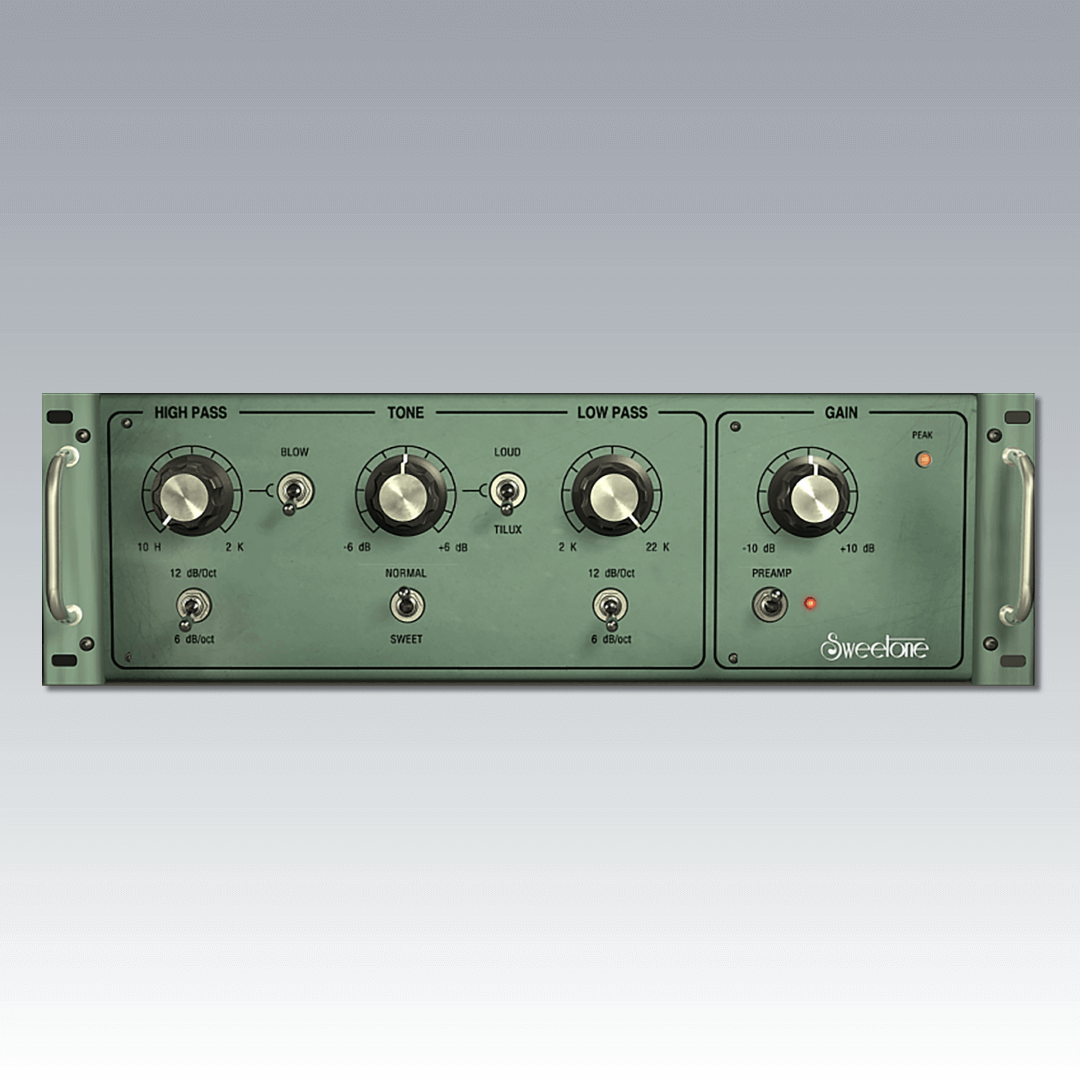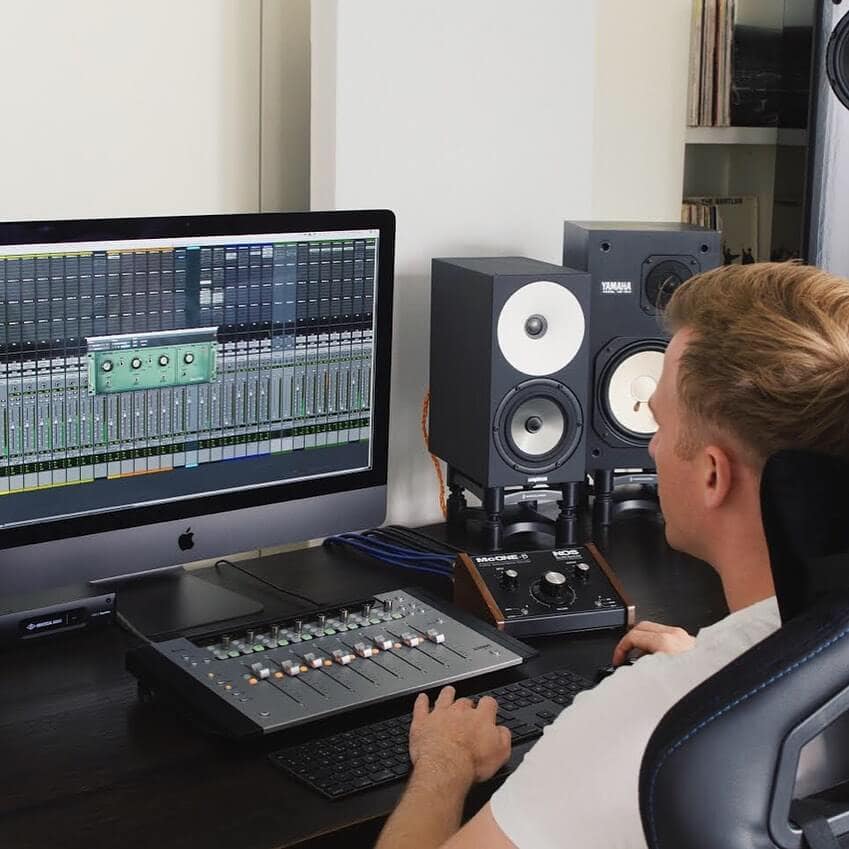Created to inspire and produce quick and effective results, Sweetone is a simple and yet powerful EQ that combines both modern and vintage characteristics. Get a full pallet of tones with minimum effort while providing sweet analog flavor with only 3 knobs. Never lose focus on your mixes again.
Leave your review.
Sweetone
$39.00
Description
Key Features
Carefully modeled preamp transformer saturation provides genuine warmth and round high end.
Two-tone control modes: Normal (based on analog gear) and Sweet.
Dual loud control modes: Normal and Sweet (both modes based on real vintage gear).
High Pass and Low Pass Filters (6 or 12 dB/Oct).
Blow mode adds fat low-end warmth to HP cut frequency.
CPU optimizations (including zero latency and no group delay) allow for a remarkably high number of Sweetone instances per session.
Internal 64-bit floating-point double precision.
A little bit of history…
Recently, we were mixing an audio production and found ourselves rushed for time. We longed for a really simple, yet powerful and effective equalizer; an EQ that could produce high-quality results easily, just by turning a pair of knobs.
I talked with many colleagues and discovered our shared need for such a tool. Although together we’d tried many products, we concluded that none met our requirements one hundred percent. Equalizers that produced good sonic results were too difficult and time-consuming in use. Products that emphasized ease of use, on the other hand, left us desiring higher quality results.
Shortly thereafter, I began research for the development of our ideal EQ: trying and analyzing various analog devices, some of which (most of which) were lent to me. Unable to find what I was looking for in a single piece of “gear,” I attempted to combine the best attributes of several units.
Once I’d found an ideal combination of characteristics from various devices, I spent a lot of time deeply analyzing them. Having worked many weeks to get consistent testing results, I began to create a prototype from scratch. Although strict emulation of various EQ characteristics may have been enough, I decided to make some changes that in my opinion marked significant improvements.
The first release of the plugin that would soon be named Sweetone was born. I excitedly put our new tool to the test under “real world” conditions. I mixed a number of projects in order to verify our prototype met my needs for a simple to use, yet powerful and effective EQ. The results were really encouraging. I soon found I could mix entire projects using just Sweetone alone.
Next, I sent the prototype to my colleagues for use in their own professional mixes. Over the course of eight weeks, I received both encouraging comments and valuable critical feedback from qualified professionals, which helped me to further improve our prototype’s sound and functionality.
During one such discussion, a colleague noted, “your plugin has a sweet tone.” “What a great name!” I thought. Initially, we called it “Sweet Tone.” But later, in the spirit of the plugin’s focus on simplicity, we shortened the name to one word: “Sweetone.”
Diego Toritto
Sweetone in depth
Tone
Sweetone has two-tone modes: Loud and Tilux. Its Tilux tone mode is inspired by a single analog unit, which has been further fine-tuned with algorithmic modifications. Loud represents a synthesis of the best features of three select pieces of analog gear.
Tilux mode provides a well-balanced tone control, with a smooth high end and fat lows. Moving the knob to the left emphasizes low frequencies and attenuates treble, reducing “harshness.” Conversely, turning the knob to the right reduces low-frequency information, and smoothly emphasizes highs.
Tilux has two modes: Normal and Sweet.
- Normal: Classic tone with a center frequency near 650 Hz.
- Sweet: “Airy” highs with a center frequency around 2 kHz.
As its name implies, Loud mode functions as a loudness filter: boosting as well as cutting selected high and low frequencies.
Loud also features two modes: Normal and Sweet.
- Normal: Functions similarly to analog equalizers; tuned to provide smooth and pleasing enhancements.
- Sweet: Based on two different analog equalizers (one chosen for its effective treatment of high frequencies, the other for its ideal handling of lows) and optimized with further algorithmic modifications.
Sweetone filters
High pass filter:
Sweetone provides two different high-pass filters: 6 dB/Oct and 12 dB/oct. Each filter has a distinctive sound and functionality.
6 dB/oct mode provides a smooth knee, making it ideal for smooth cuts. 12 dB/oct features a more abrupt cut, making it ideal for the removal of unwanted low frequencies.
Blow mode adds fat low-end warmth to HP cut frequency and is operational in both 6 dB/Oct 12 dB/oct filter settings.
Blow mode is useful in a variety of applications. For example, to emphasize sub-lows from a kick drum, activate HP Blow mode and turn the knob slowly (shift+drag) until you find the sweet spot (25hz to 50hz). Snare drum sounds can easily be “sweetened” (between 100 Hz and 200 Hz, for example) using Blow mode.
Low pass filter:
Low Pass operates as a high cut / low pass filter, carefully tuned to sound sweet and pleasant to the ear. The low pass has two modes: 6 dB/Oct and 12 dB/oct.
Sweetone Preamp
Meticulously modeled to emulate analog transformer saturation, Sweetone’s preamp section adds warmth and sweetens highs.
- High headroom (extending to +10 dBFS).
- THD: -60 dBFS.
Sweetone’s preamp section‘s “Peak” LED warns when levels approach +10 dBFS. The Peak led illuminates when the volume reaches levels of +9 dBFS (one decibel below digital “hard” clipping). If clipping occurs, Sweetone’s Peak LED will remain illuminated until mouse-clicked.
Testimonials
“In mixing, this kind of tool can be very useful for quickly altering and placing sounds in the mix. It feels less controlled than a standard parametric, but the ability to quickly get your sounds in the right ballpark cannot be underestimated.”
“As with all Sonimus products, Sweetone sounds excellent and is very simple to use. The boosts and cuts sound very natural and smooth and the filters are top-notch. The high end boosts on this unit, in particular, sounds great…”
50 reviews for Sweetone
Only logged in customers who have purchased this product may leave a review.










Nicolas C. (verified owner) –
Awesome! Easy to use just turn up a coupe knobs and get shiny high end on drums, vocals… Excellent!
Anonymous (verified owner) –
Very nice for vocals!
Andrew I. (verified owner) –
Such a versatile plugin that I use as first thing in my signal chain every single time. The preamp saturation is fantastic, a very distinct character that I love! If you really want to get a punchy sound- push the preamp to full into the A-Console, using the fader gain to compensate for the level. By doing this I reach for compressors and other EQs a lot less as this gives me all the clarity, tone shaping and saturation I want. It takes a digital, clinical signal and gives it depth, character and coherence. Looking forward to what Sonimus come out with in the future!
Christophe (verified owner) –
Sweetone is a quality tool suitable for all situations where you want to confidently and easily add a color finish, for example to compare with much more complex tools. It is very pleasant to produce a slight bass and treble contour, and a tonal rebalancing. This tool was designed by musicians, focused on the daily audio workflow. Sonimus quality!
Matt (verified owner) –
Amazing sounding smile EQ with the two different modes and ability to tighten up the low and high frequencies. A nifty and straight forward tool with the best sound.
Raman (verified owner) –
I use it on every mix especially the master and the parallel compression.
Joshua Barwick (verified owner) –
I am opposed to writing reviews as much as believing in good and bad is opposed to creativity. But Sonimus is above human invention, so just buy all their plugins right now for the ultimate sonic exaltation, or just to support the amazing crew at Sonimus – they deserve it and so much more. Thank you!
Mike Hollingsworth (verified owner) –
paolo b. (verified owner) –
Alexandre Ribeiro (verified owner) –
Brillant. Even using Burnley on the channels I could reach a perfect sweet tone adding more analog analog character for each track or bus.
Trevor Meier (verified owner) –
AU plugin doesn’t validate, and plugin aliases badly
BorisM (store manager) –
New versions are coming with oversampling for the aliasing. Btw Our first products were modeled in order to make the aliasing imperceptible to human ears ;)
Martin B. (verified owner) –
just an amazing tool
Roehl Pagala (verified owner) –
Quick support, resolved in 2days. One of the best sounding plugins…Thanks
Robert J. (verified owner) –
Efficient to get a great analog sound. Easy going tilt Eq with an added vibRrrration ))
David (verified owner) –
I mainly use only Sonimus plugins now, Great analog Sound, Great Saturation, Smooth Eq, Zero Latency and Ultra Low cpu
Michael B. (verified owner) –
Easy to use, easy to get an improved tone/eq on anything.
beatsbyjuice (verified owner) –
Sonimus five stars all around.
Filippo T. (verified owner) –
Very nice, good sounding plugin! I already midi mapped controls and I put it on every bus/main tracks to quickly adjust the tone, it’s very usefull!
I really like also the preamp saturation, but I had to link the parameter to a secondary trim plugin in chain to handle gain compensation (and this can be tricky or time spending..).
Please consider adding an auto gain compensation to make this plugin “perfect” ;)
Let’s say 4.5/5 stars because of this missing thing.. but I surely reccommend it!
Anonymous (verified owner) –
aptly named
Duncan O’Cleirigh (verified owner) –
Tobias S. (verified owner) –
Very easy and fun to work with!
Stephen R. (verified owner) –
Sweetone is like a warm blanket that you can wrap around pretty much any area of your mix to give it a bit of character.
Cost wise, its a great entry level EQ to the Sonimus product line, particularly if you’re investing in them for the first time (like myself) and don’t have a ton of cash handy.
Really lovely work from the team there!
Cheers
Fernando Campo (verified owner) –
Oz Craggs (verified owner) –
Lucas Jose Serena (verified owner) –
This one is a two way street. If you over use it, you change the tonality of the sound itself, but using it with caution this one is a set-and-forget kind of tool that balances whatever sounds it gets.
Anders Sjöholm (verified owner) –
Very easy to work with. And the sound you get out of it is top notch. Glad that I did buy it. It has been on my radar for some time. Finally pulled it.
Robert Fechter (verified owner) –
It really does add analogue to the recording! Love it.
Marcel Kanche (verified owner) –
Excellent. Simple. Intuitif.Probant !
Buddy Woodward (verified owner) –
The filters are top-notch. The high end boosts on this unit in particular sound natural and smooth. I’ve already used this in the signal chain for banjo and high-string guitar on two album projects I was hired for recently. Outstanding!
Daniel R. (verified owner) –
Great plugin! It has the best high/low pass filters I’ve found yet. Sounds great on everything I’ve used it on so far, especially my snare.
Anonymous (verified owner) –
Lovely tone, maybe most hardware alike harmonics I’ve tried on a plugin … but I don’t know too much hardware, just a couple of EQ and drives
Petr Kyrian (verified owner) –
Anonymous (verified owner) –
Smooth with nice, warm push. I use it where I used to use a Furman PQ3.
Ernesto R. (verified owner) –
It added a great sound in my mix.
Amir G. (verified owner) –
I love this eq. I use it on EVERY mix. It gets elements of the mix in line very quickly especially if you already have good sounds to begin with. It has a sweet airy pre amp sound. Not bright but very relaxed and chill. Great plugin, Sonimus!
Junior Tan (verified owner) –
Anonymous (verified owner) –
mike whang (verified owner) –
Nathan (verified owner) –
Yet to use this but if it’s like any of the others it will be 5 star
Leonardo Heiblum (verified owner) –
Anonymous (verified owner) –
The name says it all. Instant sweetness!
Kris Vasil (verified owner) –
Tilt with Character. Perfect to add body whilst smoothing out harsh frequencies (or viceversa enhance weak high end)
David C. (verified owner) –
I get immediate analog vibe from this plug in which I dig. I especially like the texture with the gain knob and tailoring sounds with the Low Pass to smooth out the high end. It’s a very useful plugin to mix with and happy with this purchase.
samy cisternas (verified owner) –
ken M. (verified owner) –
I love the Sonimus plugins! Sweetone was the last I needed to complete the collection.
Thanos Bikos (verified owner) –
Accurately named, this EQ can’t sound bad. My standard tool when I want a source to sound balanced and natural. Broad tilts and smooth filters help bass instruments take their position in the mix, brighten a piano or give it more body, soften a harsh electric guitar speaker, smoothen a violin recorded with too much presence in the highs. The minimalistic design was intimidating at first, but it certainly helps me get where I want in less time.
Pierre C. (verified owner) –
Very nice little tilt eq. Very easy and quick to use, and very nice sounding… Thanks Sonimus.
Adey M. (verified owner) –
I love all of Sonimus’s plugins, Sweetone is an appropriately named eq, perfect for applying subtle, yet significant enhancement to any instrument, either at the beginning or at the end of any processing chain
Stefano F. (verified owner) –
Perfect for my use with Audirvana
Gino T. (verified owner) –
Sweet, does the job perfectly